Last updated on May 10th, 2025 at 11:49 pm
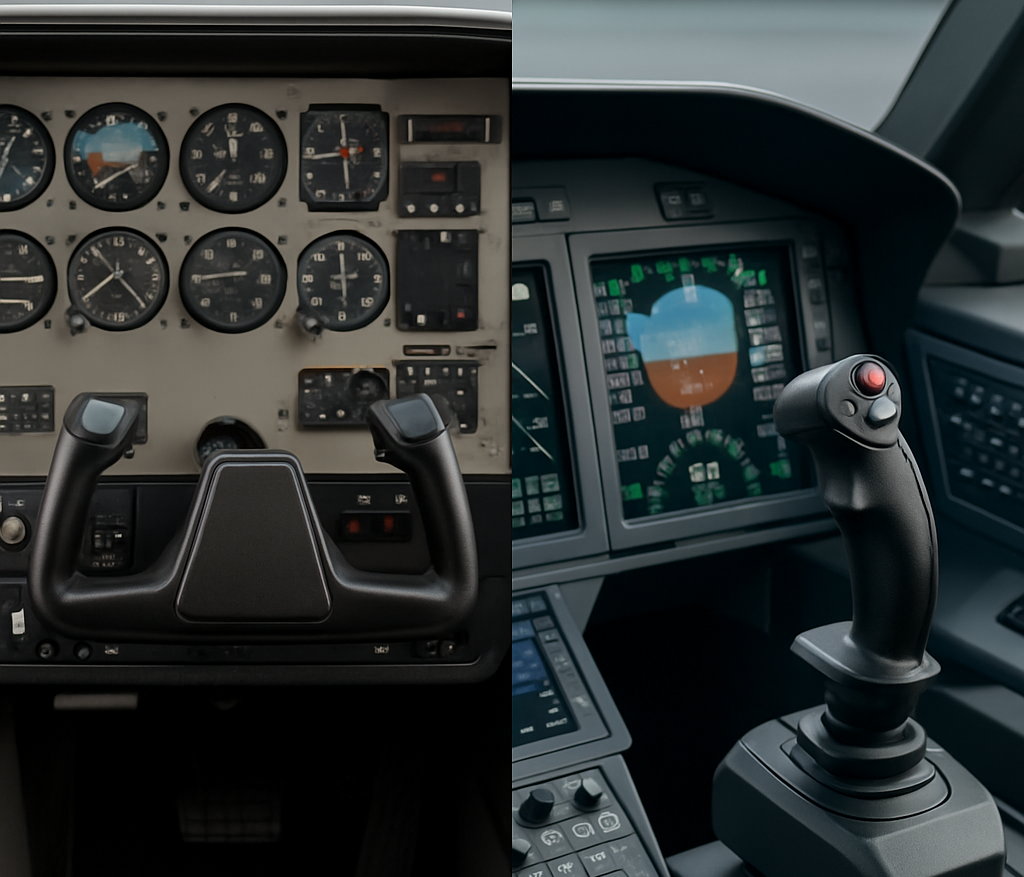
Choosing between a yoke and a joystick for your flight sim setup can feel like comparing apples to oranges. Each one has its quirks, and what feels perfect for one simmer might not click at all for another. In this article, I’ll walk you through the key differences so you can figure out which setup fits your flying style and goals. If you’re just beginning your flight sim journey, be sure to check out my step-by-step guide to getting started with flight simulation.
Understanding Yokes Vs. Joysticks
The debate over yokes versus joysticks has long been a topic among flight simulation enthusiasts and real-world pilots alike. Both devices provide ways to control and maneuver an aircraft, but each does so with a different feel and operational style. In the following sections, I break down the differences and similarities based on real-world usage, control mechanics, and even cost. This way, you get a well-rounded view before making a choice.
Yokes typically offer a classic two-hand control experience. They mimic the design you might find in many general aviation aircraft, featuring a push-pull setup for pitch and rotational movements for roll. Joysticks, on the other hand, have a more compact design tailored for quick, responsive control inputs. Understanding these nuances is key to aligning your simulation hardware with the way you prefer to fly.
Real-World Aircraft Use
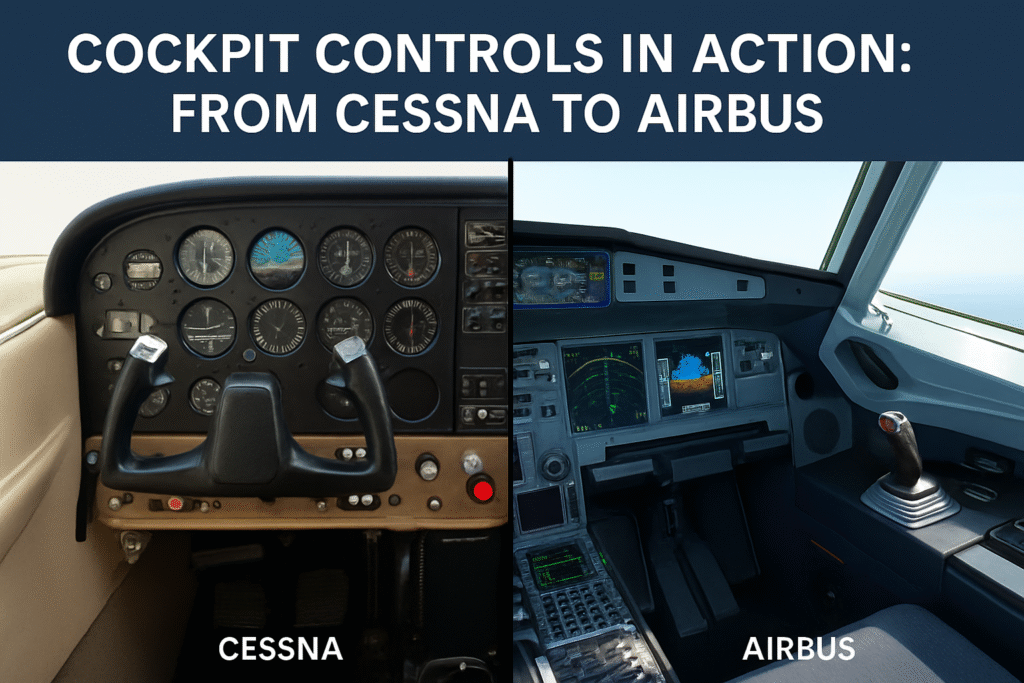
In real-world flying, the type of control system you’ll find depends a lot on the aircraft. Yokes show up in aircraft like the Cessna 172 or larger Boeing jets—so if you’re into simulating commercial or general aviation flights, they’ll feel right at home. Joysticks, on the other hand, are more common in fighter jets, helicopters, and even some modern airliners like those from Airbus. The compact design makes them ideal for high-speed or aerobatic flying—just like in real life.
Joysticks are more inclined to appear in fighter jets or helicopters. For instance, many modern Airbus planes feature a side-stick controller that shares many traits with joystick setups. The joystick’s compact design is especially handy in combat and aerobatic situations where quick reflexes and rapid adjustments are necessary. This real-world application helps inform its use in simulations, where staying true to aircraft operation is a key objective. This design is part of Airbus’s fly-by-wire system, which replaces traditional mechanical linkages with electronic controls for improved safety and performance.
Control Feel and Mechanics
How your controls feel makes a big difference in how real and enjoyable the sim becomes. Yokes give you that two-handed, cockpit-style grip with a push-pull motion for pitch and a turn for roll—just like what you’d feel in a real Cessna. Joysticks are usually one-handed, quicker, and more responsive. Some call them “twitchy,” which can actually be great if you love fast, agile maneuvers. The key is figuring out which style feels more natural to you.
Joysticks, in contrast, are typically operated with one hand. Their more condensed design means that many pilots describe the control input as being exceptionally responsive or even a bit “twitchy.” This sensitivity can be a hit with enthusiasts who prefer swift maneuvers for aerobatic or combat scenarios. Whatever your preference, understanding how these two setups operate mechanically is very important when investing in your flight simulation gear.
Precision and Range of Motion
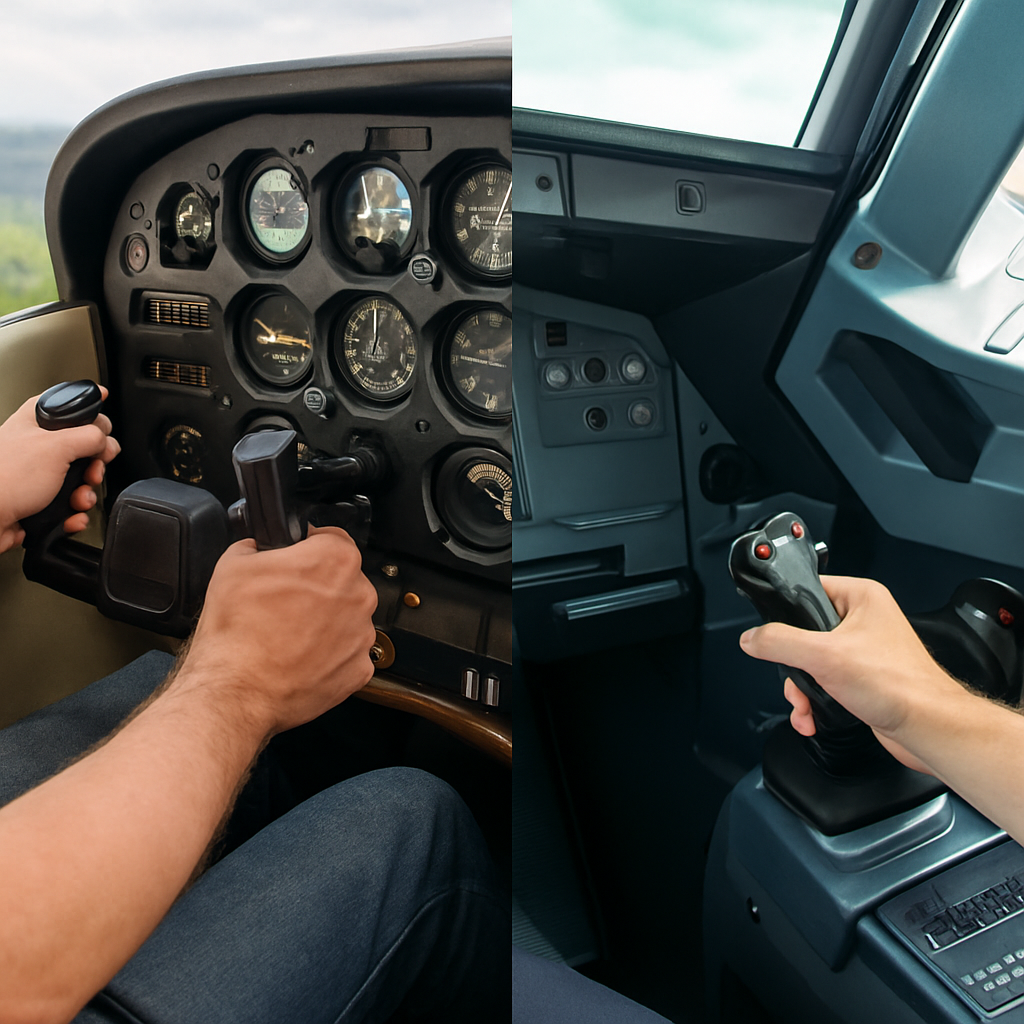
One of the key differences between these control methods is in their precision and the range of motion they offer. Joysticks often provide very precise control inputs. When executing intricate maneuvers in a combat simulation or striving for the best performance in an aerobatic routine, a joystick’s design can supply that needed accuracy. The limited range of motion works in favor of scenarios where quick, precise adjustments are critical. If you’re leaning toward a joystick setup, here’s my breakdown of the best joysticks for a realistic flight experience.
Yokes, on the other hand, generally offer a wider control arc, particularly with pitch control. This broader movement can translate to a more lifelike flying experience, especially when simulating large airliners or general aviation aircraft. However, that extra range might feel less immediate during rapid maneuvers, sometimes leaving pilots feeling a bit detached from the action when faster inputs are required. Knowing your simulation goals can help you determine which factor—precision or a natural control arc—is most important to you.
Space and Setup Considerations

Your available desk space or simulation setup environment is another important factor to consider. Joysticks are usually more compact and easier to mount. They often fit neatly on most desks, making them an excellent option if you’re working with limited space. Their streamlined design makes for a clutter-free setup that many users appreciate when keeping things simple.
Yokes, however, typically require more room. They need a larger mounting area and sometimes even a designated cockpit layout to deliver the ideal simulation environment. For those with dedicated flight sim rooms or larger desks, this isn’t an issue. But if you’re a casual user, the extra space needed could influence your decision. Ultimately, choosing a control system comes down to balancing the available space with your simulation goals.
Compatibility with Flight Simulators
Both yokes and joysticks play well with a wide range of flight simulation platforms. Whether you’re using Microsoft Flight Simulator, X-Plane, or Prepar3D, you’ll find that both controller types are widely supported. However, certain aircraft add-ons can sometimes be optimized for one system over the other. For example, the Microsoft Flight Simulator compatibility forum is a helpful place to explore which yokes and joysticks work well with the sim and get real-world feedback from other users. If you’re not sure which sim software to start with, here’s a quick look at the top 5 beginner-friendly flight simulators.
For example, add-ons that aim to simulate traditional airliners or general aviation models often deliver a more immersive experience when used with a yoke. Conversely, military jet or stunt flying simulations may feel more intuitive when paired with a joystick. Before making your decision, it’s worth checking compatibility and user reviews specific to your favorite simulation software. A well-integrated control system not only brings realism to your experience but also helps smooth the way during setup.
Button Layout and Functionality
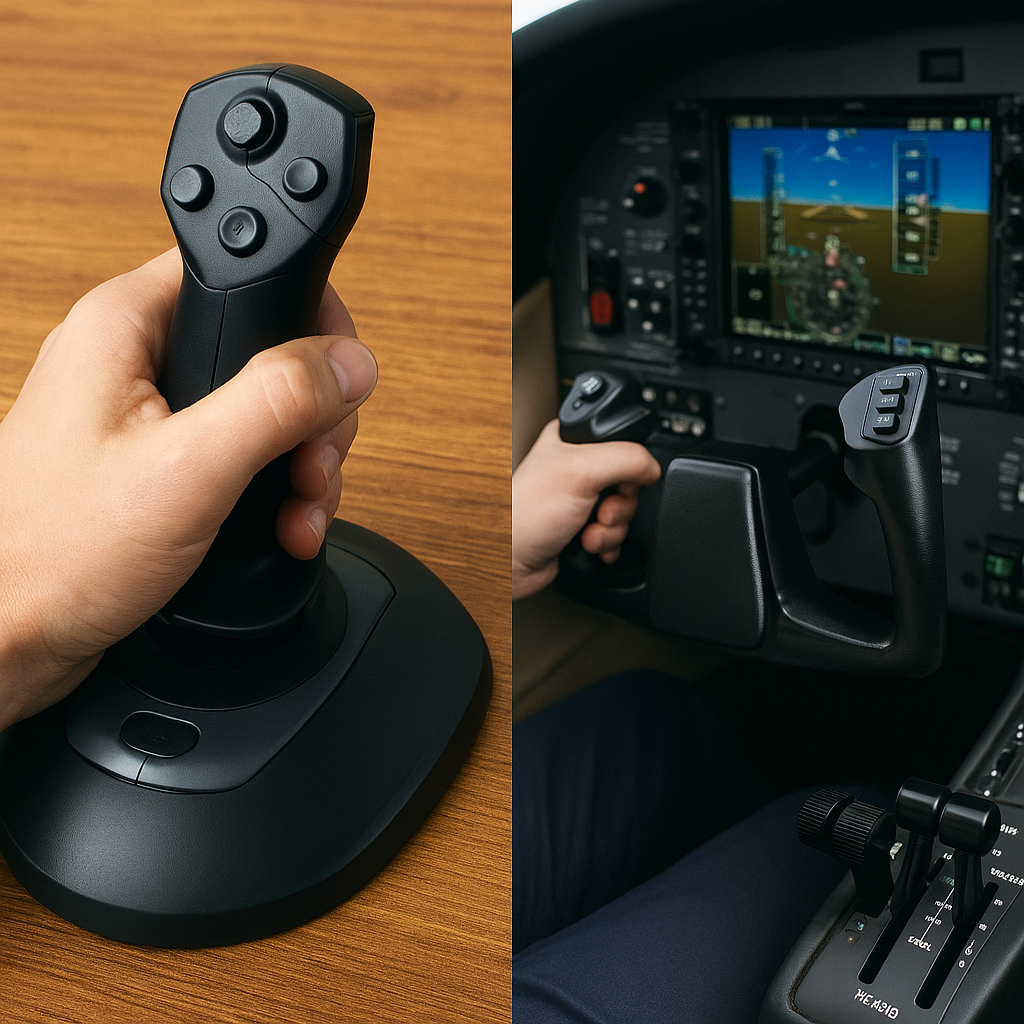
Another practical aspect to consider is the button layout and any extra controls available on the device. Joysticks frequently come with several programmable buttons and hat switches conveniently located on the grip. This setup allows for quick access to functions like camera controls, weapon systems, or flight mode changes without you having to remove your hand from the control.
In contrast, yokes often offer fewer built-in controls on the main unit. However, many yoke packages come paired with throttle quadrants and separate trim wheels, effectively simulating a full cockpit environment as seen in real-world aircraft. Depending on how you plan to use your simulator—whether it’s for casual flying or detailed flight scenario recreations—the need for integrated buttons versus dedicated throttle controls might steer your decision one way or the other. To go even further, consider adding the right rudder pedals to your setup for more precise control and realism.
Flight Experience: Which One Suits Your Style?
The ultimate choice between a yoke and a joystick depends on the kind of flying experience you are chasing. If your simulation interests lean toward airliners or general aviation aircraft, a yoke provides a more immersive, hands-on feel. The dual-handed operation alongside the realistic range of movement closely replicates traditional cockpit controls, making extended flights and training sessions feel notably authentic.
If your passion lies more with military simulations, stunt flying, or even futuristic space combat, a joystick might better suit your needs. Its rapid response rate and compact design are perfect for executing agile maneuvers that some pilots find essential in high-adrenaline scenarios. The immediate control input can be particularly helpful during those split-second adjustments demanded by such simulations.
If you’re aiming for a more authentic experience when flying general aviation aircraft or airliners, a yoke setup can really make a difference. One popular and highly-rated option is the Honeycomb Alpha Flight Controls Yoke, which offers smooth control inputs and a realistic feel for flight sim enthusiasts.
Price, Value, and Upgrade Options
The cost is always a very important consideration, especially for newcomers to flight simulation. Entry-level joysticks, such as popular models from Logitech, tend to be less expensive. They make a great starting point if you’re not yet ready to commit to a more elaborate control system. Price-wise, a joystick can deliver solid value while still offering the fundamental features you need.
Yoke setups, however, might require a larger initial outlay. Products like the Honeycomb Alpha often come bundled with throttles or trim wheels to provide a full cockpit experience. Although this increases the upfront cost, many simulation enthusiasts feel that the added realism and natural control experience justify the extra investment.
It’s also essential to think about your future upgrade path. Many users start with a basic joystick setup and later transition to a full HOTAS (Hands On Throttle and Stick) system when they desire more functionality. Similarly, yoke users frequently expand their systems with additional multi-axis throttles, trim wheels, or even complete cockpit rebuilds. Assessing your long-term simulation goals can help you decide which system will offer the best overall value for both your current setup and future upgrades. An example is the Thrustmaster HOTAS Warthog, a replica of the U.S. Air Force A-10C’s controls, offering precise input and a realistic feel.
Top-Rated Flight Simulator Yokes on Amazon
**Please note: This post contains affiliate links. As an Amazon Associate, I earn from qualifying purchases at no extra cost to you.
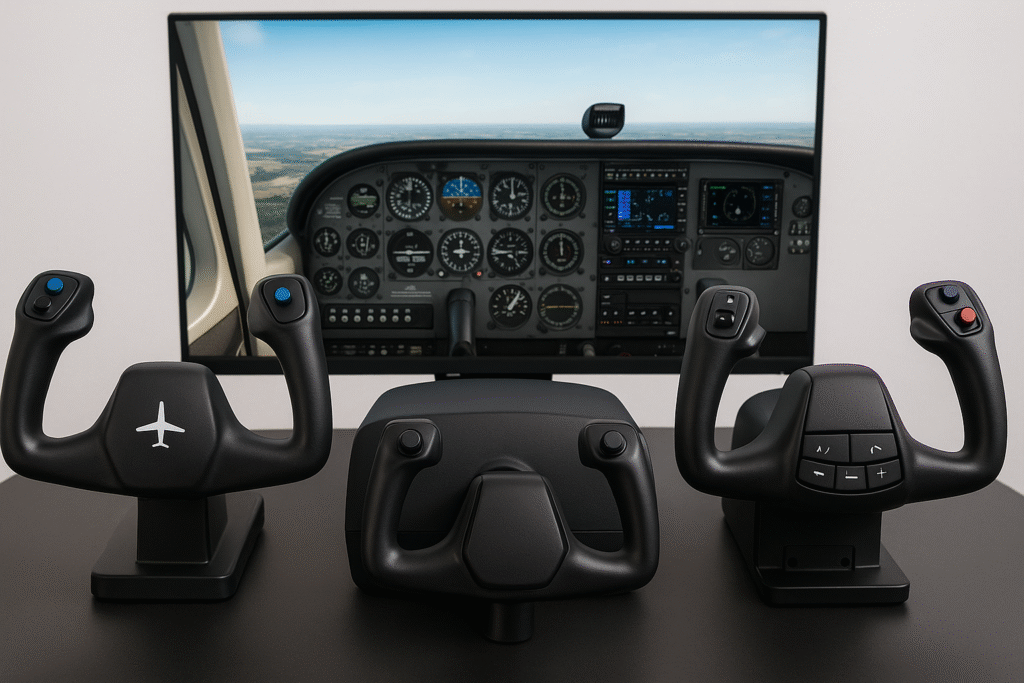
If you’ve decided that a yoke is the right choice for your flight simulator setup, picking the right one can make a huge difference in how real the experience feels. Whether you’re flying general aviation aircraft or large commercial jets, these top-rated yokes offer smooth control, quality construction, and features that match various flying styles and budgets. Below are some of the most popular and well-reviewed options available on Amazon right now.
1. Honeycomb Alpha Flight Controls Yoke
Designed by pilots and aerospace engineers, this yoke offers a realistic full 180° rotation with a solid steel shaft and dual linear ball bearings for smooth control. It includes a switch panel with master, alternator, avionics, and light switches, as well as a 5-position ignition switch.
2. Logitech G Saitek PRO Flight Yoke System
A professional simulation yoke and throttle quadrant featuring 3 modes and 75 programmable controls. It provides realistic and precise control, enhancing muscle memory for aspiring pilots.
3. Thrustmaster TCA Yoke Pack Boeing Edition
Officially licensed by Boeing, this yoke pack replicates the flight kinematics of the Boeing 787. It features a pendular mechanism for realistic control and includes a throttle quadrant with swappable levers.
4. Turtle Beach VelocityOne Flight Universal Control System
This all-in-one flight control system includes a yoke with true-to-life 180° rotation, integrated rudder controls, and a modular throttle quadrant. It’s designed for both beginner and advanced sim pilots, featuring a customizable status panel, trim wheel, and a display for real-time feedback. Compatible with Xbox Series X|S and Windows PCs, it offers a complete solution for immersive home cockpit setups.
Frequently Asked Questions
Question: How do I decide between a yoke and a joystick if I’m new to flight simulation?
Answer: Consider which type of aircraft you prefer and the maneuvers you expect to perform. If you enjoy simulating airliners or general aviation aircraft, a yoke might deliver the immersive experience you’re after. If combat or aerobatic simulations excite you more, a joystick could be a better match.
Question: Will a joystick provide enough control for serious flight simulation?
Answer: Yes, a joystick can offer very precise control and rapid response, which is particularly appealing in scenarios that require quick input. However, it might not fully replicate the dual-handed experience offered by a yoke.
Question: Are there compatibility issues between these controllers and popular simulation platforms?
Answer: Both yokes and joysticks work well with major simulation platforms like Microsoft Flight Simulator, X-Plane, and Prepar3D. Some aircraft add-ons may be optimized for one type of setup over the other, so checking user reviews and recommendations can really help guide your decision.
Question: What if I decide to upgrade my simulation setup later on?
Answer: Many flight simulation enthusiasts begin with a basic joystick or yoke system and gradually expand. Joystick setups can evolve into full HOTAS systems, while yoke configurations can be pumped up with specialized throttles and trim wheels. Both choices allow for significant growth in your simulation rig over time.
Final Thoughts
At the end of the day, picking between a yoke and a joystick really comes down to the kind of experience you want. If you’re aiming for that classic cockpit feel—like flying a Cessna or a Boeing—a yoke gives you a more hands-on, immersive vibe. But if you’re into quick, high-adrenaline flying like in combat or aerobatics, a joystick might feel more in tune with your needs. Think about your desk space, your goals, and where you want to take your setup in the future. There’s no one-size-fits-all—just what feels right for you.
Remember that your available workspace and future upgrade plans play a big role in this decision. A compact joystick fits neatly in tight spaces and can serve as a stepping stone into more advanced setups, whereas a yoke represents an investment in a truly authentic flying experience. Your simulation setup isn’t just about the current hardware; it’s also about where you see your simulation hobby growing down the line. Both choices offer unique benefits, and the decision ultimately hinges on what feels right for you. Happy flying and may your simulations always feel just a bit more real!
✈️ Personal Note:
When I first got into flight simulation, I started with a simple Logitech joystick. While I haven’t tried many other models yet, I can honestly say it gave me a great experience right from the start. It was reliable, responsive, and made learning the basics of flying much more enjoyable. Sometimes, the best setup is simply the one that works best for you.
Extra Tips for Flight Simulation Enthusiasts
If you are looking to really get into your flight simulation setup, there are several extra tips that can help you get the most out of your hardware. First, consider calibrating your controls thoroughly. Spending the time to fine-tune your joystick or yoke can make a significant difference when it comes to in-game performance. For instance, take time to map out custom button profiles that suit your specific flying style. This extra effort can make your simulation experience feel much smoother.
Another important point is to read user forums and reviews. Learning from real experiences shared by other enthusiasts can set you up for success. You might stumble upon clever modifications or adjustments that other users have made which can be directly applied to your own setup. Additionally, don’t underestimate the value of ergonomic positioning. Making sure that your control devices are at the optimal height and distance can reduce fatigue and increase your overall enjoyment during long simulation sessions.
Moreover, try to mix in some variety in your training exercises. For example, practice both slow, methodical flights and high-speed maneuvers to really get a feel for the differences between your control systems. This approach will help you make well-rounded improvements to your simulation configuration. Finally, remember that every pilot’s preference differs, so be patient while you experiment and adjust. There’s a rewarding sense of progress once you find a configuration that truly clicks.
Taking these additional tips into account as you set up or upgrade your simulation gear can add to the overall enjoyment and realism of your flying experience. The more details and personal tweaks you incorporate, the more you’ll benefit, ensuring that every flight feels like a unique adventure in its own right.
